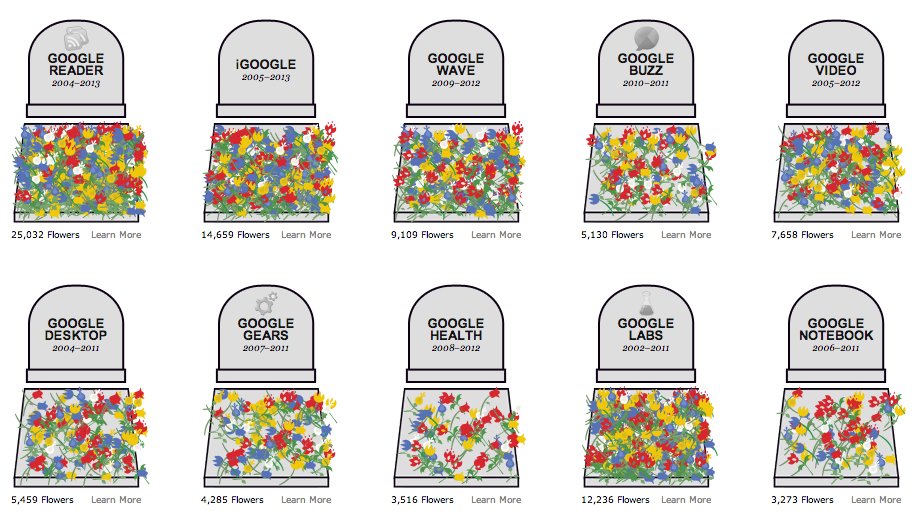Exploring the Google Cemetery
The “Google Cemetery” is a metaphorical concept that refers to a website or list that tracks and memorializes the various products, services, and projects launched by Google that have been discontinued or “killed off” by the company.
These discontinued offerings may include software, hardware, apps, and online services that, for various reasons such as low popularity, strategic shifts, or redundancy, are no longer maintained or supported by Google.
5 Dead Google Products And Why They Died
1. Google+
Google+ was a social networking platform created by Google in 2011 to allow users to connect with others, share content, and organize contacts into “Circles.”
It offered features like video conferencing through “Hangouts” and integration with other Google services. However, it faced low user engagement and privacy issues and was discontinued in 2019.
The departure of its founder, Vic Gundotra, in 2014, triggered a series of changes and a sense of disarray.
Google+ faced stiff competition from established social media giants like Facebook, which already had a strong user base and a clear plan for social networking. Google+’s complex and less user-friendly features, such as “Circles,” failed to capture the average user’s interest.
And finally, a data breach in 2018, where the data of 52.5 million users was exposed, eroded trust in the platform.
2. Google Offers
Google Offers, launched in 2011 as Google’s response to the rising popularity of daily deals and coupon sites like Groupon, struggled to gain traction and ultimately ceased operations in 2014.
Despite Google’s attempt to enter this market after an unsuccessful bid to acquire Groupon in 2010, Google Offers faced several challenges.
It was not the first player in the daily deals space, and established competitors like Groupon and LivingSocial had already captured a significant market share.
Consequently, Google Offers failed to attract a critical mass of users and local businesses, leading to its demise in 2014.
The service’s inability to differentiate itself and establish a dominant position in an already crowded market contributed to its downfall.
3. Google Wave
Google Wave, introduced in 2009, was a pioneering but perplexing platform that aimed to combine email, group chat, and document collaboration into a unified workspace.
Despite initial excitement and millions queuing up for early access, Google Wave faltered due to several key factors.
It lacked a clear focus, leaving users confused about its purpose.
The product’s positioning was unclear, with Google not directly targeting work teams, which was essential in a remote work context that would later become significant.
As a result, the initial enthusiasm quickly waned, and user retention rates plummeted.
Google Wave failed to live up to the high expectations it generated pre-launch, leading to its demise in just two years. While not commercially successful, it laid the groundwork for modern collaboration tools.
4. Google Buzz
Google Buzz, launched in 2010, aimed to compete with Twitter by integrating with Gmail and displaying content in users’ inboxes.
However, it faced multiple issues that led to its rapid demise within a year.
Google Buzz lacked a competitive advantage over Twitter, offering nothing new to users.
Privacy concerns arose due to its integration with Gmail, automatically adding contacts and revealing users’ locations. Critics raised alarm over privacy breaches, including the exposure of sensitive communications.
This led to a lawsuit costing Google $8.5 million and severely damaging the Buzz brand’s reputation.
With these problems and a lack of user engagement, Google Buzz was shut down in less than two years, making way for the ill-fated Google+.
5. Google Glasses
Google Glass, introduced in 2012, aimed to revolutionize wearable technology with voice- and motion-controlled augmented reality glasses. However, it faced several challenges, leading to its discontinuation in 2019.
The high initial cost of $1,500 and limited marketing efforts hindered its adoption.
Google Glass received substantial media attention and was embraced by celebrities but fell short of delivering on its promises, leading to overhyped expectations.
Critics and users encountered issues with the device’s functionality and design, as it looked different from traditional glasses, making it appear “geeky.”Ultimately, Google Glass failed to establish itself as a necessary or practical device for the general public, causing it to be phased out. While not officially dead, it is no longer available commercially.
Photos : enkey.it
















There are no comments
Add yours